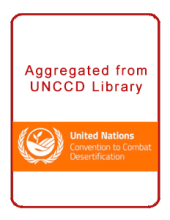Land Library
Welcome to the Land Portal Library. Explore our vast collection of open-access resources (over 74,000) including reports, journal articles, research papers, peer-reviewed publications, legal documents, videos and much more.
/ library resources
Showing items 1 through 9 of 92.The importance of land manifests in various components of the everyday lives of people insocieties: cultural heritage, livelihood, the environment, economy, and community, among manyothers. Land is a factor of development.
Since the commitments and reporting requirements of the SDGs ov erlap significantly with those of the UNFCCC and UNCCD, policy designe rs have mutually reinforcing incentives to advance this SDG commitment.
Meeting the Sustainable Development Goals requires drylands sustainability. Treating drylands as global environmental commons enables better tailored governance responses. Key nested governance elements for drylands involve setting goals, monitoring and delivering sanctions across scales.
The failure of rural economies to deliver decent work to their young people affects national economies, threatens political stability, nurtures extremism and causes socially and economically disruptive migration. Globally, youth are two to three times more likely than adults to be unemployed.
The implementation of Agenda 2063 has gathered momentum at all levels. The continent has made some remarkable
progress towards attaining the goals defined in Agenda 2063’s First Ten-Year Implementation Plan as outlined in this
report.
Resources, including minerals and metals, underpin the world’s economies for almost all sectors, providing crucial raw materials for their industrial processes.
FOOD SYSTEMS ARE EVOLVING QUICKLY TO MEET GROWING AND CHANGING DEMAND, BUT THEY ARE NOT SERVING EVERYONE’S NEEDS.
Decisions over tenure – who gets access to land, fisheries and forests, for how long, and under what conditions – have important implications for people’s livelihoods.
Dust storms are capable of transporting sediment over thousands of kilometers, but due to the Middle East and North Africa (MENA) region’s proximity to the Sahara Desert, the region is one of the dustiest in the world.


